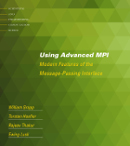Home
Publications
Awards
Research
Teaching
MPI Tutorials
CSCS'12
ISC'12
Speedup'15
PPoPP'13
ICS'13
EuroMPI'14
ISC'16
CS498
Miscellaneous
Full CV [pdf]
ew-hoefe
BLOG
bio


Events





Past Events






|
Advanced MPI at International Supercomputing Conference ICS'13
Advanced Parallel Programming with MPI
Presenters
Pavan Balaji, Argonne National Laboratory
Torsten Hoefler, ETH Zurich
Host

Abstract
The Message Passing Interface (MPI) has been the de facto standard for parallel programming for
nearly two decades now. However, a vast majority of applications only rely on basic MPI-1 features without
taking advantage of the rich set of functionality the rest of the standard provides. Further, with the advent of
MPI-3 (to be released September 2012), a vast number of new features are being introduced in MPI, including
efficient one-sided communication, support for external tools, non-blocking collective operations, and improved
support for topology-aware data movement. This is an advanced-level tutorial that will provide an overview of
various powerful features in MPI, especially with MPI-2 and MPI-3.
Detailed Description
Tutorial Goals
MPI is widely recognized as the de facto standard for parallel programming. Even
though knowledge of MPI is increasingly becoming a prerequisite for researchers and developers involved in
parallel programming institutes, including universities, research labs, and the industry, very few institutes offer
formal training in MPI. The goal of this tutorial is to educate users with advanced programming knowledge
in MPI and equip them with the knowledge of powerful techniques present in various MPI versions including
the upcoming MPI-3 standard. If the committee members have other suggestions, the presenter will be happy
to incorporate them. Based on these emerging trends and the associated challenges, the goals of this tutorial are:
- Providing an overview of current large-scale applications and data movement efficiency issues they are facing
- Providing an overview of the advanced powerful features available in MPI-2 and upcoming in MPI-3
- Ilustrating how scientists, researchers and developers can use these features to design new applications
Targeted audience
This tutorial is targeted for various categories of people working in the areas of high performance communication and I/O, storage,
networking, middleware, programming models, and applications related to high-end systems. Specific audience this tutorial is aimed at include:
- Scientists, engineers, and researchers working on the design and development of next generation high-end systems including clusters, data
centers, storage centers
- System administrators of large-scale clusters
- Developers of next generation middleware and applications
|



























